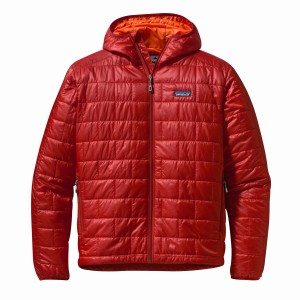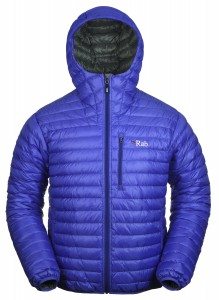Height: 6’3″
Weight: 175 lbs.
Jackets: Patagonia Nano Puff Hoody (Size M), Rab Microlight Alpine Jacket (L), The North Face Diez Jacket (M)
I remember vividly my first experience with down: a North Face vest that was big, burly, and warm as all hell. It was pretty much like wearing a sleeping bag over my pre-pubescent torso, and it was not much good for layering. I didn’t care. I wore it constantly and was content in my puffy, scrawny little world.
Mid-layers have come a long way. In terms of maintaining heat, there is no more important layer than the mid. When you move past fleece and wool, your two major choices are down and synthetic. I tested three similar options in search of the perfect lightweight mid-layer: the Rab Microlight Alpine Jacket, The North Face Diez Jacket, and the Patagonia Nano Puff Hoody.
The first two are down, the last, synthetic (PrimaLoft, specifically). One might say that comparing down to synthetic is apples and oranges, and they’d be partially correct. Down will win a warmth contest any day of the week, but synthetic stays warm even when wet, which can be crucial, depending on climate.
The Nano is designed to resist water and did so nicely when I got caught in a light shower riding my bike across Santa Fe. The majority of the water wicked off once I got off the bike, but did leave some wet patches in folds where more water had gathered. I wouldn’t wear it in much more rain than that, but it certainly performs in light to moderate snowfall. And there’s a serious advantage over the down: you don’t have to baby the Nano when things start getting wet.

The Nano also performs fairly well in the wind. Patagonia claims that the jacket is windproof, but when I wore it in some serious spring windstorms, I definitely felt some draft through the front zipper.
In terms of basic functions, the Nano is great. The YKK zipper has small teeth, which I haven’t had catching problems with and will remain durable. The hood, which is nice and stretchy, covers the head well and is meant to fit under a helmet (it’s super comfortable and feels good underneath a rock climbing helmet). It’s not the most stylish hood I’ve ever worn, but it will stay on for belays, a GS run at the resort, or in nasty storms. The hand pockets are zippered and are a good size for wallets, sunglasses, or cold hands.
On overall warmth, the Nano is the least warm of the three jackets I tested. If you’re getting into serious winter weather or overnight camps in sub-zero temperatures, look somewhere else. But the Nano performs well for its intended designed: if you’re on the move—skinning, hiking, or climbing— you’re going to be warm.
When I wore this jacket at Alta Ski Area for a spring powder photo shoot off the High Traverse, it was perfect. When we were moving, I unzipped and the Nano breathed like a champ, keeping me at the perfect temp. When we stopped or the wind picked up, I closed the pit zips and the front of my North Face shell and was perfectly toasty doing laps.
Basically, as soon as you move, this thing turns into a convection oven. It’s only when you stop and hunker down that you have problems. The synthetic simply doesn’t hold heat nearly as well as down, even though it’s two-to-three ounces heavier than the Rab Microlight or The North Face Diez. If it’s cold, you have time to stop, eat a sandwich or ride a lift before you’ll need to start moving again. If you’re sitting around camp, this jacket isn’t for you.
I wore the Rab Microlight Alpline Jacket the next day at Alta in flat light and light snow. I was almost instantly sweating. Even with my shell pit zips open wide and my front zip partially down, I was still roasting.
The Microlight is a whole different beast than the Nano. The Microlight features 750-fill European goose down and weighs a scant 12 ounces. As the name implies, the jacket is meant as a layering piece for climbing and alpine ascents. Like all the jackets in this test, it’s not meant as a stand-alone jacket, but as a layer underneath a shell.

I was not initially impressed. Out of the box, the Microlight was already showing feathers at the seams. Feather loss is part of owning a down jacket, but it shouldn’t be showing feathers when it’s brand new. I threw the jacket on for a quick nighttime bike ride and after five minutes I was sweating profusely. This thing was built for colder climates.
I took the jacket on an early spring climbing trip into New Mexico’s Jemez Mountains. There was still snow and ice in the shade, and the wind was whipping through the crag, keeping the temperature in the 40-degree range. I did a few pitches in the jacket and got too warm each time, so I started leaving it behind with my belayer. I was on the wall during a particularly bad series of gusts and turned from a rest hold to see the jacket tangled and jerking 25 yards away in a barbed wire fence. Whoops. When I got down and retrieved the jacket, there wasn’t a rip in it. Thank you, Pertex. (Pertex is the outer material used in the Microlight and the Diez. Patagonia uses a very similar ripstop material on the Nano. After months of hard testing, none of these jackets have a rip in them).
When I was belaying, I wore the hood, zipped up, and stayed at a very comfortable temperature. The hood features an easily moldable wire-brim to customize the fit to the user’s preference. Initially, I didn’t think this was good for two reasons, the first being additional weight, the second, that it could get in the way and be uncomfortable. I was wrong on both counts. The wire brim allowed me to flip the hood out into a mini-brim or tuck it back so that it sat near my hairline. It never caused me discomfort and that miniscule amount of weight kept the hood in place during wind gusts.

Awesome comparison of these jackets, I’ve been thinking about getting on of these mid layer jackets, and wasn’t sure which to get because they all are so close in design…thanks!
hi,
the jacket reviews are interesting … but i keep wondering how they perform when wearing a protektor jacket and a backback? i happen to have one from ‘belowzero’ which has nearly no insulation on the backside – which turned out to be great when wearing the described gear. now i’m looking for something similar, but i’m lost …
thanks for your opinion,
chris
You bring up the issue of fit …. what do you recommend as a layer under a shell (eg North Face Enzo). Should you go for tight, firm or loose?
thanks
Peter
@Chris-I’ve had no problem with backpack wear with any of these jackets. They’ve all been used extensively for biking, cragging, and walking around town and have held up great. I took the Microlight and the Diez backpacking in some cold New Mexican weather and they both worked well. One note on the Microlight, though: the zipper catches more and more the longer I have it. The teeth are simply too small and as the fabric gets more weary the zipper simply snags more. Annoying.
@Peter-I’m personally a fan of what one could call mid-tight (note: I made that term up). I find layers that are too tight—especially if you have to use multiple—are restrictive. I still like them to fit well, just not overly tight. Being bound up in the shoulders is a serious pet peeve of mine. Out of these jackets I really like the fit of the Microlight and the Nano Puff; the Diez is a little tight for my liking. Really though, it comes down to personal preference. Hope that helps.
I love the Patagonia NanoPuff. I was looking to replace an old fleece midlayer for winter backpacking the NH and NY. I’m 5’8″ about 185# and a medium nano fits perfect. I am an exceptionally sweaty individual and that has always been a challenge for me in winter hiking. Because of my propensity for profuse perspiration, down is out (I climbed Mt. Eisenhower in Jan. in a down coat and once below treeline I packed it up only to find it a disgusting ball of frozen sweaty feathers when I unpacked). The Nano is still quite warm, even when I’ve drenched it in sweat and it dries at warp speed. I also find it do be good enough to repel winds up to 40 mph at 15-below zero. It’s so versatile that it’s made my other mid-layers obsolete and it looks nice enough (in black) to wear around town.
Go stand on whitby pier fishing all night in any of them jackets youl freaze your arse of, I know I’ve just taken the rab one back it’s not worth the cardboard the price is stuck on, love my rab batura mind you!! But go buy a jacket from a tackle shop designed for fishing for half the prices any of them jackets cost and youl be toasty warm.